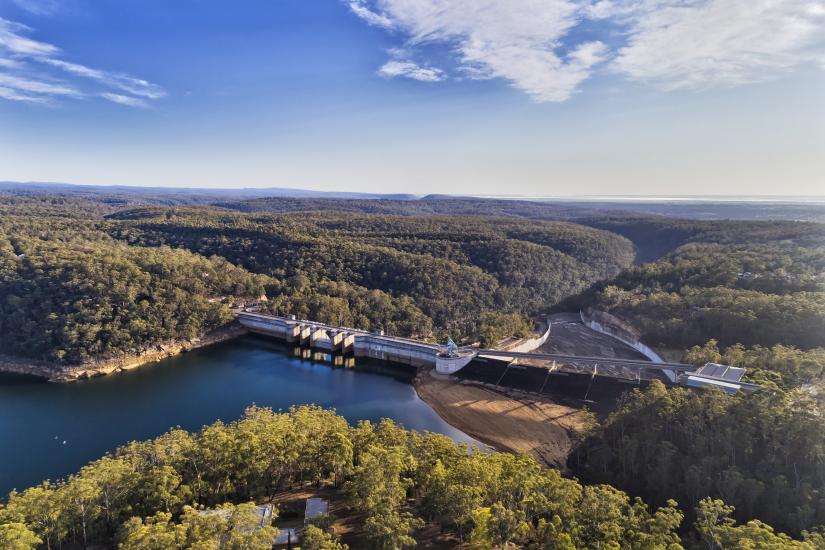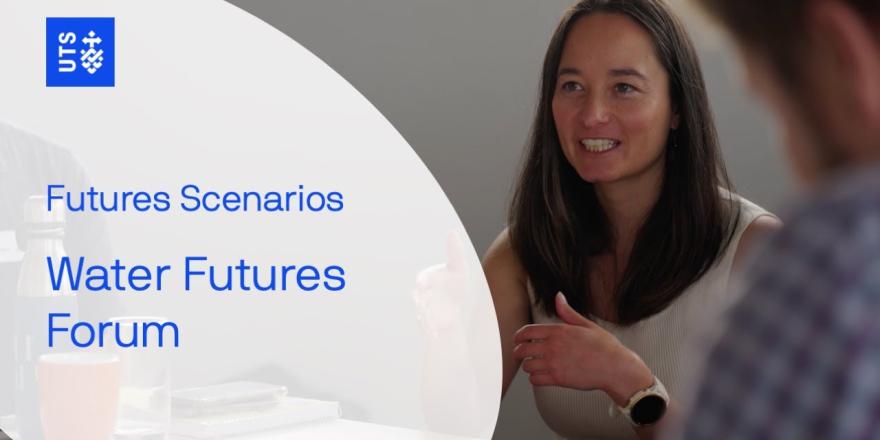Award-nominated research imagines water catchment futures through modelling and storytelling.

Water is an essential resource facing an uncertain future.
Sydney’s drinking water catchments are essential to the health and wellbeing of over 5 million residents, but they face uncertainties from climate change, population growth, and land use shifts.
The UTS Institute for Sustainable Futures (ISF), in collaboration with WaterNSW, has developed innovative future scenarios for 2040 and 2060 to tackle these challenges head-on. The research has been shortlisted as a finalist for the 2025 Australian Water Association NSW Water Awards in the R&D Excellence category.
By combining decades of historical land use data with advanced Geographic Information System (GIS) modelling, the project maps out alternate futures for Sydney’s water catchments.
These future scenarios are helping WaterNSW prepare today to protect Sydney’s drinking water decades into the future.
– A/Prof Simon Fane, ISF
These scenarios incorporate ‘science-based imagination’ to create narrative-driven models that vividly illustrate how different trends – from urban expansion to renewable energy transitions – might shape the region’s water quality and availability.
ISF Associate Professor Simon Fane says, “This project showed the power of developing narratives scenarios and linking them to quantitative modelling of alternative futures.”
“These future scenarios are helping WaterNSW prepare today to protect Sydney’s drinking water decades into the future.”
The research team’s approach offers actionable insights. For instance, the project’s ‘carbon positive’ scenario has already inspired investigations into carbon sequestration, biodiversity regeneration, and renewable energy initiatives within catchments.
These proactive measures underline how the project’s findings are translating into real-world solutions, creating pathways toward a sustainable and resilient water future.
The collaborative nature of the research – which combined ISF’s expertise in futures thinking with WaterNSW’s on-ground knowledge – has been central to its success.
Workshops with WaterNSW staff enriched the scenarios with practical insights, ensuring they reflect the diverse realities of managing catchments in a changing environment.
With its nomination for the R&D Excellence Award, this project exemplifies the power of innovation and collaboration in addressing some of the most pressing challenges facing Australia’s water industry. The recognition also highlights the critical role of forward-thinking research in safeguarding essential resources for future generations.
Watch the video below from the ISF hosted 'Water Futures Forum 2023: Preparing Futures Scenarios, Their Representation, and Application’ which looks at visualising the future for effective water planning.

Varsha Sivagurunathan:
Scenario planning essentially is about planning for alternative futures. This is especially helpful in times of increasing uncertainty in the water sector. We are finding that there are more floods and droughts and other climatic events that are affecting the way we operate. And scenario planning is essentially a tool that we can use to help prepare for those sorts of uncertain events and explore alternative futures.
So, this Forum that was titled Representing Future Scenarios, their presentation and application essentially looked at bringing together a range of different stakeholders. We had representatives from the state government, utilities, and academia. They all met, and we had a lot of engaging discussions about scenarios in the water industry. They used their knowledge, insight, and expertise to discuss how to present scenarios, how to represent them, and how to use them. It was really exciting.
Some of the questions that were explored were things around what actually makes good scenarios and what are some challenges that you face when you end up trying to create those good scenarios.
James Macken:
To start with the challenges, it's a complex and messy process. It's designed to be that by nature, meant to be uncomfortable to push our thinking beyond business as usual. So, in that sense, it's not for everyone, and it takes a bit of time to get into the right headspace and to be able to have the discussions needed to think about the future in different ways.
Rachael Wakefield-Rann:
There are many, but I think two are worth emphasising. The first is ensuring adequate participation from the right people. A lot of the time when we develop scenarios, we include people that we think are going to have relevant experience without capturing the full diversity of people that those kinds of visions or the future planning is going to affect. So, figuring out how to get the right people in the room, people from diverse backgrounds and people who might not be incentivised in any kind of conventional way, which is a huge challenge, I think, at the moment and often excludes people who are time poor or of course people who don’t speak English as a first language or may have difficulty with technology or may not be able to access transport, factors like that.
The second key factor is scalability I think, connecting visions that might be affecting a city or an entire landscape and ensuring that our thinking goes from that scale down into the home and back out again. How you actually translate things that might happen at a micro scale up through the miso and to kind of the macro level of understanding of what's happening.
Craig Ma:
When I think about how we can most effectively use scenarios, there are a few things that might help that process along. The first is something I call bookending. So, depending on the scenario, if you can bookend it with a narrative or a description that is quite tangible and plausible and relatable to others, then that's a really good frame to start with. The second thing I would add to the mix is if we can at least timestamp the scenario, give it a sense of urgency or give others an ability to understand how much time do we have to better understand what the scenario might mean for them is also a very useful tool.
And perhaps the final thing would be if we can more effectively link the scenario back to our risk practices, then that really helps people understand the implications of the type of scenario we're talking about.
Ann-Marie Rohlfs:
Scenarios are used most effectively when they're interactive, when they're brought to life. So, that might be through making them visual, making them interactive, and having participants come and discuss them.
Varsha Sivagurunathan:
So, the Forum concluded with a discussion around the future of futuring in the water sector. Some of the key points and themes that emerged from all of our discussions during the day were about the role of stakeholders. Who should be involved in the process? How do we engage with different stakeholders in a meaningful way to create really good scenarios? The discussions from the day will be useful for policymakers and water planners as we start this journey of planning for uncertain futures in the water industry.

